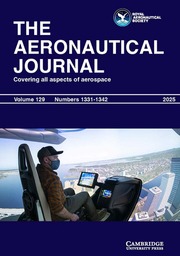No CrossRef data available.
Article contents
Utilisation of insect-inspired blades for improvement of a commercial propeller aerodynamic performance
Published online by Cambridge University Press: 17 September 2025
Abstract
Bio-inspiration can be used to improve the aerodynamic performance of commercial multirotor propellers. In the present study, insect wings are used as a source of inspiration, and the effects of inspiration from insect’s wing shape on the propeller performance–, especially this effect on parameters like thrust, torque, and propeller efficiency, are investigated. Six insect species have been selected as inspiration: Hemiptera, Orthoptera, Neuroptera, Mantodea, Odonata and Hymenoptera. The analyses have been done using the numerical simulation of flow and the moving reference frame (MRF) method alongside the SST k-ω turbulence model. The simulations were carried out over a range of rotational speeds, varying from 4,000 to 8,000 rpm, for propellers with a diameter of 0.24 m. All propellers utilised the Eppler E63 airfoil. To ensure the accuracy of the present numerical simulation results, validation was done by comparing them with experimental data from the DJI Phantom-3 propeller. The results of validation showed significant agreement with the experimental data. The results indicated that the insect-inspired propellers generate higher thrust compared to conventional propellers. Additionally, for a constant thrust force, the inspired propellers exhibit lower rotational speeds. Moreover, in terms of thrust, the Hemiptera insect-inspired propeller outperforms the DJI Phantom-3 propeller, achieving a notable average improvement of 34.182%.
Information
- Type
- Research Article
- Information
- Copyright
- © The Author(s), 2025. Published by Cambridge University Press on behalf of Royal Aeronautical Society


